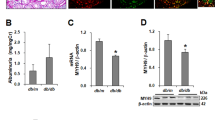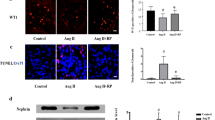Abstract
Angiotensin II (AngII) is capable of inducing calcium/calcineurin signaling and podocyte injury; however, the precise underlying mechanism is not well understood. Because we have previously demonstrated that microRNA-30s (miR-30s) inhibit calcium/calcineurin signaling in podocytes, we hypothesize that AngII may induce podocyte injury by downregulating miR-30s and thereby activating calcium/calcineurin signaling. To test this hypothesis, we used an AngII-induced podocyte injury mouse model. The mice were treated with AngII via infusion for 28 days, which resulted in hypertension, albuminuria, and glomerular damage. AngII treatment also resulted in a significant reduction of miR-30s and upregulation of calcium/calcineurin signaling components, including TRPC6, PPP3CA, PPP3CB, PPP3R1, and NFATC3, which are the known targets of miR-30s in podocytes. The delivery of miR-30a-expressing lentivirus to the podocytes on day 14 of the infusion ameliorated the AngII-induced podocyte and glomerular injury and attenuated the upregulation of the calcium/calcineurin signaling components. Similarly, treatment with losartan, which is an AngII receptor blocker, also prevented AngII-induced podocyte injury and calcium/calcineurin signaling activation. Notably, losartan was found to sustain miR-30 levels during AngII treatment both in vivo and in vitro. In conclusion, the effect of AngII on podocytes is in part mediated by miR-30s through calcium/calcineurin signaling, a novel mechanism underlying AngII-induced podocyte injury.
Key messages
• AngII infusion resulted in downregulation of miR-30s in podocytes.
• Exogenous miR-30a delivery mitigated the glomerular and podocyte injuries induced by AngII.
• Both miR-30a and losartan prevented AngII-induced activation of calcium-calcineurin signaling.






Similar content being viewed by others
References
Faul C, Asanuma K, Yanagida-Asanuma E, Kim K, Mundel P (2007) Actin up: regulation of podocyte structure and function by components of the actin cytoskeleton. Trends Cell Biol 17:428–437
Shankland SJ (2006) The podocyte’s response to injury: role in proteinuria and glomerulosclerosis. Kidney Int 69:2131–2147
Abdi-Ali A, Mann MC, Hemmelgarn BR, Mac Rae JM, Turin TC, Benediktsson H, Sola DY, Ahmed SB (2015) IgA nephropathy with early kidney disease is associated with increased arterial stiffness and renin-angiotensin system activity. J Renin-Angiotensin-Aldosterone Syst 16:521–528
D’Agati VD, Kaskel FJ, Falk RJ (2011) Focal segmental glomerulosclerosis. N Engl J Med 365:2398–2411
Kobori H, Nangaku M, Navar LG, Nishiyama A (2007) The intrarenal renin-angiotensin system: from physiology to the pathobiology of hypertension and kidney disease. Pharmacol Rev 59:251–287
Snijder PM, Frenay AR, Koning AM, Bachtler M, Pasch A, Kwakernaak AJ, van den Berg E, Bos EM, Hillebrands JL, Navis G et al (2014) Sodium thiosulfate attenuates angiotensin II-induced hypertension, proteinuria and renal damage. Nitric Oxide 42:87–98
Hsu HH, Hoffmann S, Di MGS, Endlich N, Peter-Katalinić J, Weide T, Pavenstädt H (2011) Downregulation of the antioxidant protein peroxiredoxin 2 contributes to angiotensin II-mediated podocyte apoptosis. Kidney Int 80:959–969
Ideura H, Hiromura K, Hiramatsu N, Shigehara T, Takeuchi S, Tomioka M, Sakairi T, Yamashita S, Maeshima A, Kaneko Y et al (2007) Angiotensin II provokes podocyte injury in murine model of HIV-associated nephropathy. Am J Physiol Renal Physiol 293:F1214–F1221
Greka A, Mundel P (2012) Calcium regulates podocyte actin dynamics. Semin Nephrol 32:319–326
Eckel J, Lavin PJ, Finch EA, Mukerji N, Burch J, Gbadegesin R, Wu G, Bowling B, Byrd A, Hall G et al (2011) TRPC6 enhances angiotensin II-induced albuminuria. J Am Soc Nephrol 22:526–535
Nijenhuis T, Sloan AJ, Hoenderop JG, Flesche J, van Goor H, Kistler AD, Bakker M, Bindels RJ, de Boer RA, Möller CC et al (2011) Angiotensin II contributes to podocyte injury by increasing TRPC6 expression via an NFAT-mediated positive feedback signaling pathway. Am J Pathol 179:1719–1732
Lewis EJ, Hunsicker LG, Clarke WR, Berl T, Pohl MA, Lewis JB, Ritz E, Atkins RC, Rohde R, Raz I (2001) Renoprotective effect of the angiotensin-receptor antagonist irbesartan in patients with nephropathy due to type 2 diabetes. N Engl J Med 345:851–860
Reiser J, Mundel P (2007) Dual effects of RAS blockade on blood pressure and podocyte function. Curr Hypertens Rep 9:403–408
Nagata K, Somura F, Obata K, Odashima M, Izawa H, Ichihara S, Nagasaka T, Iwase M, Yamada Y, Nakashima N et al (2002) AT1 receptor blockade reduces cardiac calcineurin activity in hypertensive rats. Hypertension 40:168–174
Bartel DP (2004) Micro RNAs: genomics, biogenesis, mechanism, and function. Cell 116:281–297
Shi S, Yu L, Chiu C, Sun Y, Chen J, Khitrov G, Merkenschlager M, Holzman LB, Zhang W, Mundel P et al (2008) Podocyte-selective deletion of dicer induces proteinuria and glomerulosclerosis. J Am Soc Nephrol 19:2159–2169
Ho J, Ng KH, Rosen S, Dostal A, Gregory RI, Kreidberg JA (2008) Podocyte-specific loss of functional microRNAs leads to rapid glomerular and tubular injury. J Am Soc Nephrol 19:2069–2075
Wu J, Zheng C, Fan Y, Zeng C, Chen Z, Qin W, Zhang C, Zhang W, Wang X, Zhu X et al (2014) Downregulation of microRNA-30 facilitates podocyte injury and is prevented by glucocorticoids. J Am Soc Nephrol 25:92–104
Wu J, Zheng C, Wang X, Yun S, Zhao Y, Liu L, Lu Y, Ye Y, Zhu X, Zhang C et al (2015) MicroRNA-30 family members regulate calcium/calcineurin signaling in podocytes. J Clin Invest 125:4091–4106
Harvey SJ, Jarad G, Cunningham J, Goldberg S, Schermer B, Harfe BD, McManus MT, Benzing T, Miner JH (2008) Podocyte-specific deletion of dicer alters cytoskeletal dynamics and causes glomerular disease. J Am Soc Nephrol 19:2150–2158
Liao TD, Yang XP, Liu YH, Shesely EG, Cavasin MA, Kuziel WA, Pagano PJ, Carretero OA (2008) Role of inflammation in the development of renal damage and dysfunction in angiotensin II-induced hypertension. Hypertension 52:256–263
Wennmann DO, Hsu HH, Pavenstädt H (2012) The renin-angiotensin-aldosterone system in podocytes. Semin Nephrol 32:377–384
Zhang C, Li Y, Wang C, Wu Y, Cui W, Miwa T, Sato S, Li H, Song WC, Du J (2014) Complement 5a receptor mediates angiotensin II-induced cardiac inflammation and remodeling. Arterioscler Thromb Vasc Biol 34:1240–1248
Nitschke R, Henger A, Ricken S, Gloy J, Müller V, Greger R, Pavenstädt H (2000) Angiotensin II increases the intracellular calcium activity in podocytes of the intact glomerulus. Kidney Int 57:41–49
Wang L, Chang JH, Paik SY, Tang Y, Eisner W, Spurney RF (2011) Calcineurin (CN) activation promotes apoptosis of glomerular podocytes both in vitro and in vivo. Mol Endocrinol 25:1376–1386
Ilatovskaya DV, Levchenko V, Lowing A, Shuyskiy LS, Palygin O, Staruschenko A (2015) Podocyte injury in diabetic nephropathy: implications of angiotensin II-dependent activation of TRPC channels. Sci Report 5:17637
Brenner BM, Cooper ME, de Zeeuw D, Keane WF, Mitch WE, Parving HH, Remuzzi G, Snapinn SM, Zhang Z, Shahinfar S (2001) Effects of losartan on renal and cardiovascular outcomes in patients with type 2 diabetes and nephropathy. N Engl J Med 345:861–869
Kinoshita Y, Kondo S, Urushihara M, Suga K, Matsuura S, Takamatsu M, Shimizu M, Nishiyama A, Kawachi H, Kagami S (2011) Angiotensin II type I receptor blockade suppresses glomerular renin-angiotensin system activation, oxidative stress, and progressive glomerular injury in rat anti-glomerular basement membrane glomerulonephritis. Transl Res 158:235–248
Hoffmann S, Podlich D, Hähnel B, Kriz W, Gretz N (2004) Angiotensin II type 1 receptor overexpression in podocytes induces glomerulosclerosis in transgenic rats. J Am Soc Nephrol 15:1475–1487
Sonneveld R, van der Vlag J, Baltissen MP, Verkaart SA, Wetzels JF, Berden JH, Hoenderop JG, Nijenhuis T (2014) Glucose specifically regulates TRPC6 expression in the podocyte in an AngII-dependent manner. Am J Pathol 184:1715–1726
Jia J, Ding G, Zhu J, Chen C, Liang W, Franki N, Singhal PC (2008) Angiotensin II infusion induces nephrin expression changes and podocyte apoptosis. Am J Nephrol 28:500–507
Jaafar F, Righi E, Lindstrom V, Linton C, Nohadani M, Van Noorden S, Lloyd T, Poznansky J, Stamp G, Dina R et al (2009) Correlation of CXCL12 expression and FoxP3+ cell infiltration with human papillomavirus infection and clinicopathological progression of cervical cancer. Am J Pathol 175:1525–1535
Guo J, Lou W, Ji Y, Zhang S (2013) Effect of CCR7, CXCR4 and VEGF-C on the lymph node metastasis of human pancreatic ductal adenocarcinoma. Oncol Lett 5:1572–1578
Zhou Y, Kong X, Zhao P, Yang H, Chen L, Miao J, Zhang X, Yang J, Ding J, Guan Y (2011) Peroxisome proliferator-activated receptor-α is renoprotective in doxorubicin-induced glomerular injury. Kidney Int 79:1302–1311
Fu J, Wei C, Lee K, Zhang W, He W, Chuang P, Liu Z, He JC (2016) Comparison of glomerular and podocyte mRNA profiles in Streptozotocin-induced diabetes. J Am Soc Nephrol 27:1006–1014
Acknowledgments
This work was supported by the Major International (Regional) Joint Research Project (81320108007), the Major Research Plan of the National Natural Science Foundation (91442104), and grants from the National Natural Science Foundation of China (81600559, 81500549) and a research grant from **ling Hospital, Nan**g University School of Medicine (2016035).
Author information
Authors and Affiliations
Contributions
Y.Z., Z.L., and SS designed the study. J.W., Y.Z., M.Z. (M Zhang), X.Z. (X Zhu), X.Z. (X Zhou),Y.L., and F.Y. performed the experiments. Y.Z. and M.Z. (M Zhou) did data statistics. F.X. did the mesangial expansion quantification. Y.Z. and S.Y. analyzed mouse data. Y.Z., Z.L., and S.S. wrote the manuscript. All authors have reviewed and approved the final version of manuscript.
Corresponding authors
Ethics declarations
Conflict of interest
The authors declare that they have no conflict of interest.
Electronic supplementary material
ESM 1
(PDF 32 kb)
Rights and permissions
About this article
Cite this article
Zhao, Y., Wu, J., Zhang, M. et al. Angiotensin II induces calcium/calcineurin signaling and podocyte injury by downregulating microRNA-30 family members. J Mol Med 95, 887–898 (2017). https://doi.org/10.1007/s00109-017-1547-z
Received:
Revised:
Accepted:
Published:
Issue Date:
DOI: https://doi.org/10.1007/s00109-017-1547-z




